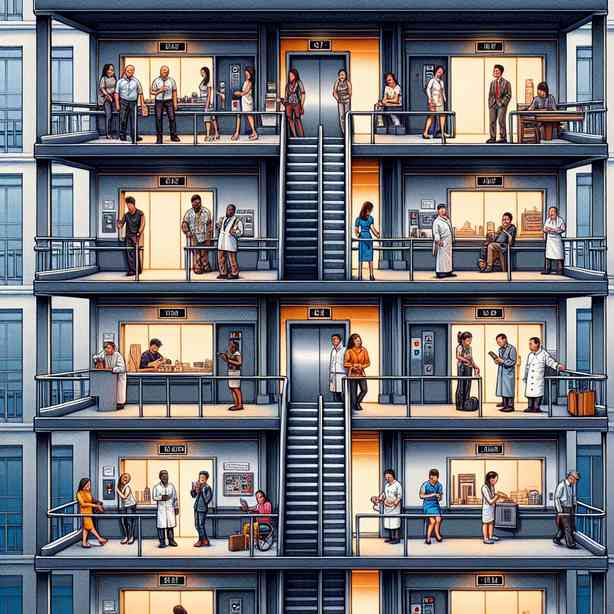
When the elevator stops at every floor, it can prompt both fascination and frustration among passengers. The elevator serves as a microcosm of society, a space where diverse individuals gather, often leading to various interactions and experiences. In this discourse, we shall explore the implications, functions, and psychological effects of an elevator that halts at every floor.
Elevators play a crucial role in enabling vertical transportation in buildings. They are engineered to provide swift access to different levels, ensuring convenience and efficiency. However, when an elevator stops at every floor, it prompts us to reconsider our understanding of time and space in this confined environment. While it may seem tedious, stopping at every floor can create opportunities for social interaction that might not occur in a high-speed elevator.
One of the primary benefits of stopping at every floor is the facilitation of interaction among occupants. When the elevator doors open at each level, it allows those waiting to board an immediate opportunity to join. This creates a space where conversations can begin, and connections can form, regardless of whether we are in a high-rise office building or a residential complex. It transforms a simple ride into a social experience, reminding us of the importance of human interaction in our daily lives.
The psychological effects of these encounters are notable as well. In a fast-paced world where individuals often rush from one place to another, taking a moment in an elevator, even with stops at every floor, can serve as a pause for reflection. Passengers are invited to exist together in a shared space for a limited time, leading to moments of shared laughter or small talk – elements that enrich our social fabric. Through this dialogue, individuals can feel a sense of commonality and community, which is often missing in our daily routines.
Moreover, stopping at every floor allows for a more deliberate consideration of the environment around us. Elevators furnished with posters or screens often provide information about building events, safety procedures, or even art installations. This exposure can enhance passengers’ experience by offering them insights into the culture and vibrancy of the building and its community. Hence, elevators perform an essential role not only in physical transportation but also in delivering information and stimulating engagement among residents and visitors.
However, it’s essential to acknowledge that this phenomenon may also lead to a feeling of impatience among some individuals. In our society, where efficiency and speed are highly valued, the idea of an elevator that stops at every floor may feel counterproductive, especially for those in a hurry. The key lies in balancing the paradox of efficiency and the human need for interaction. Although some may dread slower elevators, there is an inherent value to be found in these brief pauses, which can lead to serendipitous connections unexpectedly.
Additionally, stopping at every floor can be a metaphor for life’s journey. Just as the elevator pauses to pick up new passengers or let others off, our lives are filled with moments of change and transition. Each stop signifies a new opportunity, be it personal or professional. To embrace these pauses is to embrace growth and possibility. This metaphor encourages an appreciation of the journey rather than solely focusing on the destination.
To further enhance the experience of an elevator that stops at every floor, it may be beneficial to incorporate thoughtful design elements. Elevators that feature ambient lighting, soothing music, or interactive displays can transform the ride into a more enjoyable and enriching experience. Additionally, adapting the size and layout of the elevator to accommodate social gatherings or conversations can foster a more inclusive atmosphere. Such considerations can revolutionize our perception of these small yet significant spaces.
From a practical standpoint, having an elevator that stops at every floor can also serve necessary functions for individuals with mobility challenges. It guarantees that all residents and visitors can access every level of the building, thus promoting inclusivity. Elevators must be designed to accommodate everyone, ensuring that no individual is left behind. This aspect reinforces the importance of accessibility in modern architecture, highlighting how essential it is for our built environments to cater to diverse needs.
As we conclude this exploration, it is evident that when the elevator stops at every floor, it does more than simply facilitate movement; it prompts us to slow down, engage, and reflect. It encourages connections, serves as a reminder of the human aspect of our environments, and symbolizes the various pathways we encounter in life. While some may view the frequent stops as an inconvenience, there is undeniable value in these moments. They represent opportunities for growth, community building, and personal connections that enrich our lives.
Ultimately, it is essential to embrace the journey, even when it requires an elevator that stops at every floor. In doing so, we cultivate a greater appreciation for the shared human experience, fostering a sense of unity and belonging in an often chaotic world. So, the next time you find yourself in an elevator that takes its time, perhaps take a moment to enjoy the ride. Who knows what serendipitous encounters or reflections may await you on each floor?


